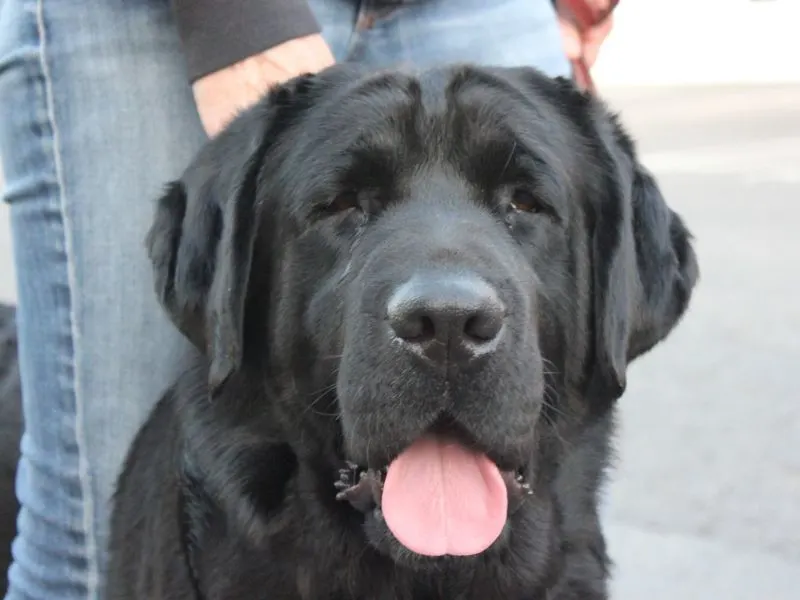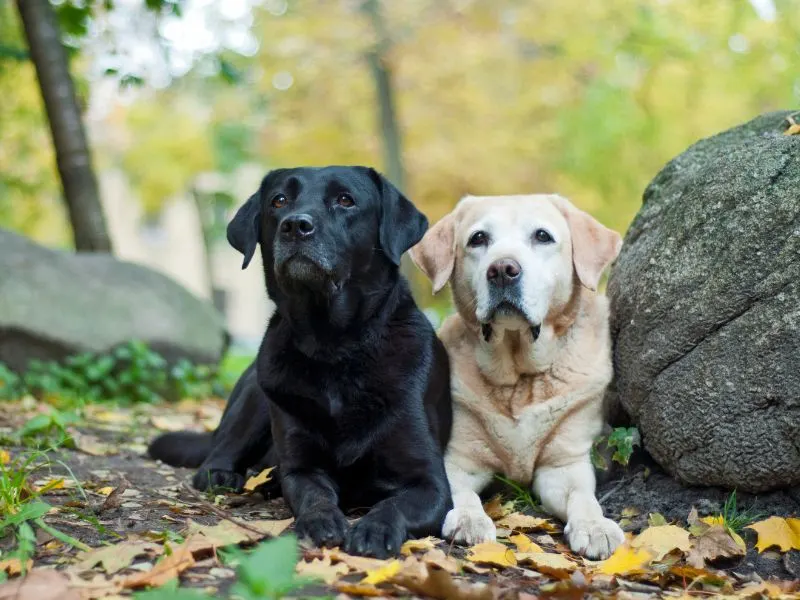You’ve decided that you want to get a Labrador retriever. After all, they’re known to be great family dogs.
And they’ve been the most popular breed for years in the United States.
Now you have to determine what type you want, but what’s the difference between American vs English Labs? And which type best fits your lifestyle?
In this article, I’ll explain the difference between the two types.
And I’ll discuss their needs and how they can fit into your lifestyle.
I’ve had friends and clients who have had each type and have trained both varieties.
Although all labs should be energetic dogs, the difference between the appearance and temperament of the two types is real.
Of course, there are some exceptions.
The Origin of the Lab
The Labrador breed originated in Newfoundland, Canada, working with fisherman in harsh, icy conditions.
In the early 1800s, English noblemen, who were impressed with the breed, took some back to the United Kingdom and bred them.
Eventually, after showing in conformation became popular in the 1940s, two different types of labs became popular.
Over the years, labs bred in England were bred more for show and appearance, which is bred for conformation trials. They became known as English labs.
And USA-bred labs were at first produced for hunting and participating in field trials. They became known as American labs.
Of course, both types are now bred in the United States and in England, but for different purposes.
What’s the Breed Standard for the American vs English Lab?
Neither the American Kennel Club (AKC) nor the United Kennel Club, the two largest registries in the United States, distinguish between the two types.
Under the AKC standard, males should stand between 22.5 and 24.5 inches at the shoulder and weigh between 65 and 80 pounds.
Females should stand between 21.5 and 23.5 inches at the shoulder and weigh between 55 and 70 pounds.
Both have a water-resistant double coat and come in three colors: black, yellow, and chocolate.
The Physical Differences Between the American vs English Lab
There are marked physical differences between American and English labs.
Although the breed standard doesn’t differentiate between the American and English lab, in reality they usually look quite different within that standard.
English Labs:
- Are much bulkier looking
- Have shorter legs
- Have a more substantial, shorter body with barrel chests
- Have a solid build with a stocky appearance
- Have a wider, more blocky head. with a shorter muzzle and a more pronounced stop
- Have a more powerful-looking neck
- Have a double coat that’s noticeably thicker than is found on American labs
- Have a thicker, more Otter-like, straighter tail
American (aka Field-Type) Labs:
- Have a much more athletic build that is ready to work
- Have a finer-boned, slimmer, lighter overall appearance
- Have a narrower head and skull with a sharper, more contoured face.
- Look more like a canine athlete than his bulkier English-lab relative
- Are taller with longer legs
- Are thinner with a longer neck as well
- Have a thinner tail that sometimes has a slight curl.
What Were American vs English Labs Bred for?
The difference in appearance between the two types of labs can be traced back to what they were bred to do.
The decades-long breeding accounts for the difference in appearance between the two types.
American labs were bred to work, which accounts for their slim, more agile breeding. They are known as field labs.
They were bred to hunt and flush out game. So they generally are more energetic and have a higher drive than English labs do.
They’re lithe, agile frame appears as if they are always in motion–or should be.
Their higher energy level sometimes gives them the label of being high-strung.
They’re also considered to be more headstrong because of their working drive.
A friend of mine only has American labs.
She does field work with them and participates very successfully in field trials.
When she isn’t training for trials, she’s out hiking with her dogs.
She has them retrieve bumpers in water.
Her dogs also are highly trained in obedience. They’ve obtained many titles with top placements.
They do scent discrimination where they find an item she touched by scent; heel with perfection; retrieve a dumbbell over a jump; know hand signals; and come when called even in distracting settings.
She even works them in the rain or snow to meet their needs–not to mention they both enjoy it and have fun.
Her labs would be extremely bored–and even potentially destructive–if they led the life of a couch potato.
English labs generally need to meet the exacting conformation standard for Labrador retrievers.
They have been bred to be displayed in the show ring.
Generally, they’re more mellow than American labs are. They’re calmer and sweeter and more laid back.
So English labs often have a leg up (pun intended) over American types in the breed ring.
They are selectively bred for their appearance and any working abilities aren’t at the forefront of qualities desired or sought after when being bred.
A friend of mine has an English-type lab.
Although the dog needs exercise, a few fetch sessions and a few daily walks is sufficient for Maddie to be calm in the house.
Of course, she also participates in obedience and rally because the dog enjoys it and needs training.
Temperament and Personality Traits of all Labrador Retrievers
Even though there are marked differences between American and English labs, they are both one breed.
And all labs should be friendly and sociable.
Also even though American labs may have more drive, all labs have a higher energy level than many other breeds do.
They all need training and physical and mental stimulation.
Highly playful and slow maturing, all labs need attention and guidance to be the best companions they can be.
They’re very affectionate to family members and haven’t met a stranger if properly socialized.
All labs should be good with children and other dogs.
And they’re heavy shedders year-round.
Specific Traits of American Labs
They are the Energizer Bunny of labs.
Bred to work, they have boundless energy and are always “on.”
They may have too much energy and be hyperactive for most people.
They need a job and aren’t satisfied just lying around most of the time.
They’re more headstrong and driven than their English-type cousins.
They’re more excitable and the elite athletes of the canine world.
In a study cited Companion Animal Psychology in 2014, they have been considered to be more trainable, attention-seeking, and responsive as well as better retrievers in fetching.
Given the fact that they were bred for hunting, they were found to be less fearful of loud noises and less likely to bark.
After all, they were bred to retrieve fowl. And they have to be quiet not to disturb their prey and can’t be afraid of gunshots in performing their work.
In another study published on March 10, 2016, working labs scored significantly higher on responsiveness than show labs did.
It was noted that gundogs are expected to be responsive and obedient for long periods of time when working.
Specific Traits of English Labs
English labs are less high-strung and are calmer at a younger age than American labs are.
They generally are more eager to please their owners. And they make a more well-behaved companion.
In the study conducted in 2014, they were found to be less fearful of humans, objects, and noise in general.
The 2014 study noted that the differences between the labs may be because of genetics because they were bred for different purposes, the environment because they were raised and trained differently, or a combination of both factors.
The 2016 study indicated that show dogs are probably not as demanding of their owners.
Show dogs are selected and bred mainly for their appearance and relaxed behavior.
They must be tolerant of handling by strangers, ignore other people and dogs, and stand still for longer periods of time.
After all, when being shown, handlers bait their dogs into a show stance and they need to wait until the judge makes the rounds to see how well they meet the breed standard.
Should You Choose an American, Field-Bred Lab?
Are you a couch potato or active? If you consider a fun day to consist of hiking, taking long walks, and being outdoors, an American lab might be a good fit.
And if you want to enter field trials or hunt, it’s an easy decision.
But you need to meet their physical and mental demands or they can be too much for a family to handle.
They can be hyperactive and can become bored. And a bored dog can become destructive.
So, to meet their needs, you must make sure that they don’t have excess energy to burn.
And, in addition to field trials, they are candidates for performing obedience commands, tricks, agility, dock diving, and rally.
When making a decision what type of lab is for you, take into account the extra time and energy you’ll need to satisfy an American lab.
This can also mean that they require more financial resources because you may need to take obedience or other performance lessons like agility to have a well-behaved lab.
Give them activity toys too. You need to take the edge off and dispel both their physical and mental excess energy.
Should You Choose an English, Show, Conformation Lab?
If you’re interested in participating in conformation trials, an English lab is probably a better choice as they’re generally preferred in the show ring.
They’ve been bred mainly for their appearance not working ability.
But also consider your lifestyle.
Although all labs are active, English labs are generally less so.
As long as they’re given enough physical and mental exercise to meet their needs, they can be happy lounging at your feet.
A couple of nice walks and fetching may be enough without having to take long treks or jogging.
They haven’t been bred to have a high-drive, “always on” personality and temperament.
They also become calmer at a younger age than American labs do.
So, if your family would rather take shorter walks, not participate in canine activities, an English lab might be a better fit.
I’ve trained both types of labs and recommend an American lab only to families who are very active and who will include their dog in their outings.
One family I worked with purchased an American-type lab. They contacted me when they were at their wit’s end because of the lab’s misbehavior.
The dog constantly mouthed their arms and clothes while they were wearing them.
He grabbed things off tables and played “catch me if you can.”
He constantly ran out the door, running around to burn off excess energy.
I found that part of the problem was that the lab had no real training.
But what they perceived to be his misbehavior often resulted from his lack of exercise and a job to do.
So we began on a journey.
Training basic commands was easy.
But I also had to make the family understand that he needed a sufficient amount of exercise.
They decided to take the pup on a few daily, long walks. And they played fetch with him outside regularly.
We even set up a small agility course that he learned to love.
In addition to private lessons, they also took an obedience course with me.
And I had them purchase some durable puzzle toys that they rotated and gave some to him on a daily basis.
With all the components in place: obedience, an appropriate amount of exercise, and play, the lab became a different dog.
He no longer shredded sweaters, grabbed arms, or was a whirlwind in the house.
But it took a large time and financial commitment by the owners to achieve success.
Another working-type lab that I trained had quite a different result.
The family had young children and, unfortunately, no time for the dog.
They contacted me after the lab was knocking over the kids as if they were bowling pins and shredding their sofa.
Unfortunately, their solution was to lock the dog in a room and avoid him.
So, when I arrived, the poor dog was like a hurricane barreling out as he ran out of his confinement.
I spoke with the owners in depth regarding what the dog required so that the humans and canine could live peacefully.
After a couple of training sessions, I could see that the lab wasn’t receiving the training or physical or mental exercise he required.
So I had a blunt discussion that I didn’t think that the dog was a good fit for their family.
The clients almost seemed relieved. They no longer wanted him but felt ashamed to give him up.
I told them not to feel bad and that it was right to re-home the lab for his benefit–and for theirs.
We found a home for the lab where the owners were active and committed to training him.
It was a win-win.
Whether you decide on an American or English lab, keep in mind that both are high energy dogs who are loyal to their families.
FAQs
Is there a difference between an American and English lab? Are they different in appearance only?
American and English labs are different in appearance as well as working drive. American labs are sleeker and taller.
They are very athletic and have a working drive. On the other hand, English-type labs have a stocky build and have less drive than American-type labs.
I’m thinking about getting a lab. My family loves to take walks, but we don’t go hiking or do many outdoor activities. Should we get a lab?
Yes–if you’re able to take your lab on a few long walks a day, play fetch, teach obedience commands, and give him enrichment activity toys. All labs are energetic.
But an English lab sounds like a better fit than an American lab. English labs are generally more sedate whereas American labs are canine athletes that require much more exercise and a job to do.
I want a dog with drive and like labs. Would a lab be the right choice?
A lab could be the right choice. If you want to have a dog for hiking, hunting, dock diving, and retrieving, an American lab would probably be a better fit than an English lab would.
American labs are bred to work and are canine athletes.
Final Thoughts
All healthy labs are energetic and lovable. And they all need physical and mental exercise to be healthy and happy.
But, when choosing a lab, you should be aware of the differences between the American-type lab and the English-type lab.
Take a hard look at your lifestyle and how much energy, time, and resources that you’re willing and able to give to your new dog.
American-type labs are canine athletes and need a job to do.
They require enough physical and mental exercise to meet their needs so that they don’t become destructive.
They won’t do well if your idea of fun is lounging on the couch watching television.
But if you hunt, hike, or otherwise have fun in the outdoors where your dog can accompany you and be trained to assist you, an American lab might be a good fit.
English-type labs are bred more for their appearance than for their working ability.
So, although they need exercise, they won’t be as demanding as an American-bred lab.
Some fetching and a few walks will probably satisfy their needs. Then, they can settle in with you and watch your favorite television series.
Of course there are exceptions to every rule and either type might take on characteristics of the other.
So once you decide on the right lab for you, find a breeder who is conscientious, does the proper health clearances of the parents, and who will guide you to the right lab for your family.
Great breeders care where their dogs are placed and will help you in making the correct decision.



